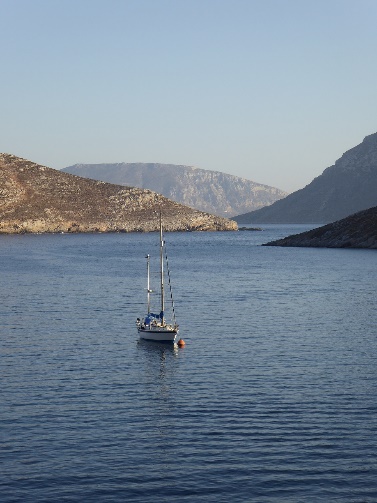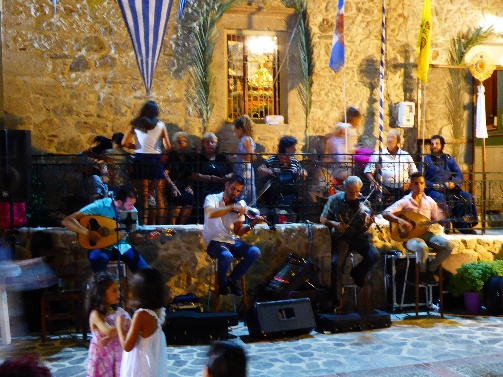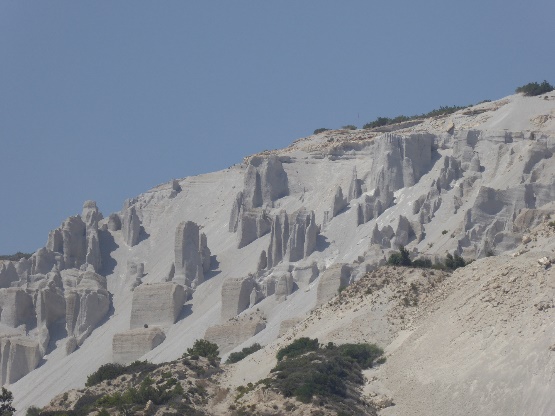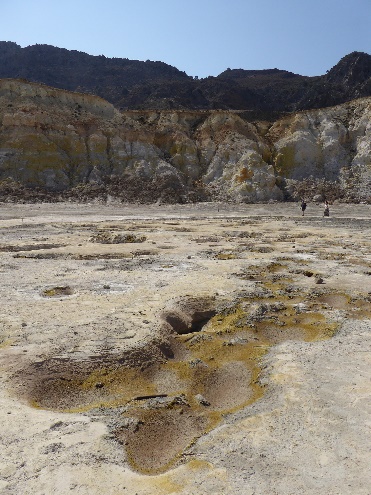August 2017 : Slowly through the Dodecanese
LaterEarlier |
The month started with Chris and Aremiti in Leros, getting on with a few mid-voyage jobs, and Julia in the UK visiting her Mum. On Julia’s return the weather had changed to the sort of benign conditions we could only dream of in windy July. We spent a couple more days in the marina at Lakki – a friendly workaday town which we grew quite fond of. Our endeavours there resulted in two significant improvements to the boat – a sturdy passarella and mesh shade panels for the cockpit. Then off again - first to explore a little more of Leros. The anchorage of Xerocambos – didn’t quite meet the strict criteria for ‘idyllic anchorage’ (too large to be intimate) – but came pretty close – with the jingling of goat bells, cocks crowing, the sight of scooter loads of hay being taken off presumably to feed the goats, fishermen leaving the harbour in their tiny boats in the early evening and the view out south to Kalymnos just 2 miles south. The village was a mix of local homes and low key holiday lets. We liked it so much we stayed 3 days.
Our next island was Kalymnos. We felt fond of this island even before getting there, recalling the little flotilla of four large fishing boats who invited us to join their raft in Santorini a couple of years ago, when the excessive depth of water in the caldera thwarted our attempts to anchor.
After a couple of days we moved southwards down the fearsomely barren and mountainous west coast to the cove of Vlikadia. This settlement, appearing to cater to the Greek holiday market, was not particularly attractive. The holding wasn’t particularly good either – with two of the four other yachts in the cove dragging their anchors in the middle of the night in strong gusts. However, we achieved our purpose with a visit to the quirky ‘Sea World’ museum – a collection of miscellaneous exhibits of all things sea, with the major focus on the sponge diving industry for which Kalymnos is famous. A real labour of love – though sadly the collection is poorly labelled and some exhibits decaying. Finally on to the capital of Kalymnos – Pothia. This large (for these parts) town,
spreads up the towering mountains around a bay - an amphitheatre of Greek houses of
varying eras in pale pastel colours.
As so to Kos which we approached with some trepidation given its touristic reputation. However we wanted to give it a fair chance and spent our first day exploring the main town. With our negatively prejudiced anticipation it was perhaps inevitable that we would be pleasantly surprised - finding effectively two towns – areas of anonymous tourist tat, English bars and nightclubs, contrasting with what is effectively a vast outdoor archaeological museum with numerous sites of ancient ruins dotted around the town. We had the ancient ruins almost to ourselves while the people up partying all night to the heavy thump thump thump of the all night discos slept in – or went out on boat trips. Something for everyone. In between, there are handsome and shady residential streets of 1930s style buildings with Art Deco touches – dating from the period when the island was under Italian ownership and rebuilt following a devastating earthquake in 1933. Signs of the earthquake off Kos last month were evident as soon as we stepped ashore at the marina, with a number of long cracks to the quays. We heard of damage to yachts – mainly by clashing masts as the water surged in and out, rising and falling by a metre for several hours. A few boats on the hard were knocked down. In town damage to the harbour waterfront is worse and there is damage to several of the ancient sites – worst to the Muslim fountain next to the plane tree where Hippocrates is said to have taught his followers, which has collapsed. The venerable tree itself seemed unscathed. Unfortunately we found the island as a whole tended to confirm our expectations and to have lost its identity as a Greek island. Of course we find ourselves disparaging tourists and the effects of tourism while being tourists ourselves. The term tourist covers a wide spectrum from those interested in finding out about different cultures, history, architecture, etc., and those on holiday looking for sunshine, fun and relaxation. The two aren’t always compatible and it is, for us, sad when in catering for holidaymakers/visitors, some locations destroy their essence. We picked up our friend Jean in Kos to continue our trip southwards.
Next to Tilos about 15 miles south – first to a rather blustery anchorage on the west side of the island, before moving round to the small port of Livadhia on the east. We explored this island by bus – first to the capital, Megalo Chorio, with its museum of mini-elephant bones – the elephants having been stranded here by rising sea levels and evolving to a size more appropriate to a small island. We climbed high up to an ancient settlement – though only Chris made it right up to the ubiquitous Knights’ castle. Then Mikro Chorio – an 18th century village up from the port, which was finally abandoned only in the 1960s. All that is now left operating are a couple of churches and, bizarrely, a nightclub. Jean left us in Tilos, taking the ferry back to Kos, and now we are on Symi – with more guests expected in a couple of days. While writing this our magnificent anchorage has filled up during the day with about 20 boats – mainly motor-boats, plus a few gulets and yachts – nearly all from Turkey just 4 miles across from the entrance to the bay. The atmosphere has changed completely from spectacular natural wonder to a jolly playground – lots of splashing in the water and pop music thumping out from one of the gulets – though no jet-skis - yet. Everyone is evidently having a great time – but personally we’ll enjoy it more when most of them leave, tranquillity returns and the focus is back on the awesome surroundings. |
 Greetings from Aremiti, in Ormos Thessalona on the island of Symi – one of the most
spectacular anchorages we have ever been to – certainly in Aremiti. The cliffs around us
rise vertically several hundred feet, there is a little pebble beach with a chapel
amongst tamarisks and pines at one end of it, and goats are bleating as they pick their
way precariously up and down the steep slopes beside us. It is quite breath-taking. We
arrived yesterday early evening and had the place to ourselves and two Turkish gulets.
Greetings from Aremiti, in Ormos Thessalona on the island of Symi – one of the most
spectacular anchorages we have ever been to – certainly in Aremiti. The cliffs around us
rise vertically several hundred feet, there is a little pebble beach with a chapel
amongst tamarisks and pines at one end of it, and goats are bleating as they pick their
way precariously up and down the steep slopes beside us. It is quite breath-taking. We
arrived yesterday early evening and had the place to ourselves and two Turkish gulets.  Finally to Pandeli – where we encountered the first signs of higher impact tourism with
its waterfront of bars and beach packed with loungers and sun umbrellas. The draw here
is the stupendous castle high up on peak above the harbour. Constructed of same grey
stone on which it stands, it seems to emerge naturally from the summit. The castle
itself – one of the Knights of St John strongholds which every island hereabouts sports
- seemed to be in a state of abandonment and looked very uncared for. However, the
eccentric curator of the little museum housing various religious artefacts was bursting
with historical information on the castle and island from ancient times until now –
including, bizarrely, that Ginger Baker’s father is one of the British soldiers buried
in a war grave, from the abortive British landing on the island in 1943. We really liked
Leros a lot. While it doesn’t boast serious ancient ruins, or sites of religious
significance, neither are there megalithic hotels or streets of souvenir shops - it
seems to have struck the right balance regarding tourism.
Finally to Pandeli – where we encountered the first signs of higher impact tourism with
its waterfront of bars and beach packed with loungers and sun umbrellas. The draw here
is the stupendous castle high up on peak above the harbour. Constructed of same grey
stone on which it stands, it seems to emerge naturally from the summit. The castle
itself – one of the Knights of St John strongholds which every island hereabouts sports
- seemed to be in a state of abandonment and looked very uncared for. However, the
eccentric curator of the little museum housing various religious artefacts was bursting
with historical information on the castle and island from ancient times until now –
including, bizarrely, that Ginger Baker’s father is one of the British soldiers buried
in a war grave, from the abortive British landing on the island in 1943. We really liked
Leros a lot. While it doesn’t boast serious ancient ruins, or sites of religious
significance, neither are there megalithic hotels or streets of souvenir shops - it
seems to have struck the right balance regarding tourism.  Our first stop was the bay of Emborios – a small village set in bay with all round
shelter from both mainland and islands – a stunning setting of towering, almost
threatening mountains and rocky crags. The village appeared in imminent danger from the
massive boulders strewn around the scree slopes just above. The tavernas here have laid
out mooring buoys allowing for a greater number of yachts to visit – and eat in their
establishments. Chatting to one proprietor it turned out that his uncles and cousins
owned most of the tavernas and holiday lets throughout the village. Obviously an
enterprising lot.
Our first stop was the bay of Emborios – a small village set in bay with all round
shelter from both mainland and islands – a stunning setting of towering, almost
threatening mountains and rocky crags. The village appeared in imminent danger from the
massive boulders strewn around the scree slopes just above. The tavernas here have laid
out mooring buoys allowing for a greater number of yachts to visit – and eat in their
establishments. Chatting to one proprietor it turned out that his uncles and cousins
owned most of the tavernas and holiday lets throughout the village. Obviously an
enterprising lot.  Just an unassuming workaday town, we immediately
found Pothia immensely appealing and friendly. Our visit coincided with the 15 August
religious festivities – involving a long service in a church on the quay to the
accompaniment of a droning chorus, culminating in the processing of the icon. This was
followed the next day by live traditional music provided by a local band – father and
three sons – on bouzouki and violin. The music was wild and wonderful and watching the
elegant and restrained Greek dancing getting hectically faster and faster was a
tremendously joyous experience. Needless to say, we bought sponges – from an ancient
sponge diver selling from his boat with his proud grandson. We were rather captivated by
the island of Kalymnos overall - a great rock of a place with only two valleys in which
grow anything, it seems to have bred a rugged race of people who have had to turn to the
sea for their existence – hence the tradition of sea-faring – long distance fishing and
sponge diving all over the Mediterranean. The island has a great sense of its own
identity, drawing back emigrants from the communities it has formed in cities in
Australia and the USA.
Just an unassuming workaday town, we immediately
found Pothia immensely appealing and friendly. Our visit coincided with the 15 August
religious festivities – involving a long service in a church on the quay to the
accompaniment of a droning chorus, culminating in the processing of the icon. This was
followed the next day by live traditional music provided by a local band – father and
three sons – on bouzouki and violin. The music was wild and wonderful and watching the
elegant and restrained Greek dancing getting hectically faster and faster was a
tremendously joyous experience. Needless to say, we bought sponges – from an ancient
sponge diver selling from his boat with his proud grandson. We were rather captivated by
the island of Kalymnos overall - a great rock of a place with only two valleys in which
grow anything, it seems to have bred a rugged race of people who have had to turn to the
sea for their existence – hence the tradition of sea-faring – long distance fishing and
sponge diving all over the Mediterranean. The island has a great sense of its own
identity, drawing back emigrants from the communities it has formed in cities in
Australia and the USA.  So far tourism had not had an overwhelming impact on the places we had visited. However,
as we headed further south towards Kos we wondered what to expect. We soon found out –
on the tiny island of Pserimos. We had conflicting reports of the little harbour – from
being a haven of tranquillity and goat bells, to being so jam packed with trip boats
that we wouldn’t be able to get in. Unfortunately for us the latter description was true
– clearly it’s all about timing – and mid August clearly isn’t compatible with
peacefulness. Of course yachts don’t have sole rights to pretty harbours and bays – but
when several hundred people are brought to one small place it becomes a different place.
So far tourism had not had an overwhelming impact on the places we had visited. However,
as we headed further south towards Kos we wondered what to expect. We soon found out –
on the tiny island of Pserimos. We had conflicting reports of the little harbour – from
being a haven of tranquillity and goat bells, to being so jam packed with trip boats
that we wouldn’t be able to get in. Unfortunately for us the latter description was true
– clearly it’s all about timing – and mid August clearly isn’t compatible with
peacefulness. Of course yachts don’t have sole rights to pretty harbours and bays – but
when several hundred people are brought to one small place it becomes a different place.  After generally
benign weather for the first three weeks of the month, Jean’s arrival coincided with
stronger winds, which resulted in some great sailing, but made our choice of anchorages
edgier. We spent the first night anchored in strong wind off Kardamena, before moving on
south to the small island of Yiali close to Nisyros, on a quest for swimming in
turquoise water. Yiali is a tiny island formed of pumice and obsidian, with a large
quarry and loading chutes. The anchorage below the pumice quarry while not
conventionally pretty had fascinating views – especially the pinnacles of pumice – and
the desired turquoise water. The following day, having spied a couple of yachts leaving
the harbour of Pali on the island of Nisyros four miles south we set off in the
knowledge there would be free spaces! As we drew closer we were amazed and bemused to
watch as more and more yachts exited the harbour. Once inside we discovered that the
harbour had been a venue for the 85 yachts participating in the Aegean Regatta. How they
all fitted we cannot imagine, but no doubt the tavernas relished the influx of 800
hungry sailors. They were a great sight with spinnakers up in wind which we thought
required only a reefed genoa!
After generally
benign weather for the first three weeks of the month, Jean’s arrival coincided with
stronger winds, which resulted in some great sailing, but made our choice of anchorages
edgier. We spent the first night anchored in strong wind off Kardamena, before moving on
south to the small island of Yiali close to Nisyros, on a quest for swimming in
turquoise water. Yiali is a tiny island formed of pumice and obsidian, with a large
quarry and loading chutes. The anchorage below the pumice quarry while not
conventionally pretty had fascinating views – especially the pinnacles of pumice – and
the desired turquoise water. The following day, having spied a couple of yachts leaving
the harbour of Pali on the island of Nisyros four miles south we set off in the
knowledge there would be free spaces! As we drew closer we were amazed and bemused to
watch as more and more yachts exited the harbour. Once inside we discovered that the
harbour had been a venue for the 85 yachts participating in the Aegean Regatta. How they
all fitted we cannot imagine, but no doubt the tavernas relished the influx of 800
hungry sailors. They were a great sight with spinnakers up in wind which we thought
required only a reefed genoa!  The little harbour of Pali is quintessentially Greek, but the real draw of the island is
the volcano caldera from which it is formed. We hired a car for a day’s exploration –
first into the caldera in which are several craters. The volcano is currently dormant
and walking inside one of the craters, with fumiroles gently steaming at the edges was
an awesome experience. We also visited the villages of Nikea and Emborios perched
precariously on the edge of the caldera in typical Greek mountain village fashion –
located to escape the ravages of pirate attacks in medieval times.
The little harbour of Pali is quintessentially Greek, but the real draw of the island is
the volcano caldera from which it is formed. We hired a car for a day’s exploration –
first into the caldera in which are several craters. The volcano is currently dormant
and walking inside one of the craters, with fumiroles gently steaming at the edges was
an awesome experience. We also visited the villages of Nikea and Emborios perched
precariously on the edge of the caldera in typical Greek mountain village fashion –
located to escape the ravages of pirate attacks in medieval times.